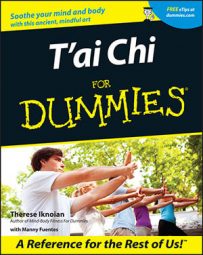Wellness for energy and happiness is not only about the movements (or forms) you practice, but about the principles by which you practice the movements. If you tap into the principles properly, you discover the stillness in the movement and, in turn, the energy that flows through your spirit.
Slowing down — Principle #1
Go slowly. This, my little Grasshopper, is the Grand Ultimate Principle (if there was such a title). Think about what your body is doing and concentrate on what comes next. Slowing down also lets you have moments along the way to take stock of what your body is doing and feeling instead of zooming past that chance. In other words, slow down to smell the daisies.
In contrast to the physical reasons for slowing down, going slower also leaves you time to experience a mindful calm, which may help you get your chi flowing correctly. That’s the Grand Ultimate. Find the stillness in your slow movement and the movement in the quiet stillness.
Taking it easy — Principle #2
In the Western world, forcing things is a way of life. Many people make things happen while tensing up or clenching — physically and/or mentally.
Use your mind to relax the body, and use your body to relax the mind. Holding extra tension in your body means expending extra energy. Save your energy for when you really need it — during your wellness practice.
Thinking in curves — Principle #3
From a mindful perspective, a rounded or curved joint or limb promotes better energy flow throughout your body. A sharply angled joint is like a soda straw bent over too far: Lemonade can’t get up and into your mouth, no matter how hard you try.
When the chi flows smoothly, you’ll realize why you worked on being curvy. And your insides will thank you for it.
Being simple — Principle #4
Simplicity boils down to the ability to live fully and naturally, moving and feeling the way that feels best. This ability can be difficult for most people to attain, considering today’s frenzied pace that encourages you to have one eye on tomorrow and your other eye on the cell phone.
Simplicity also refers to the ability to do things with as little effort as is necessary. You’ve likely seen pictures of amazing feats of strength displayed by people who don’t look as if they could muster the strength to smoosh a spider. That’s because these people dissect the task simply and use only the effort needed for the task at hand.
Simplicity also means to go with what feels natural to your body during your wellness practice. If going from one form to another feels twisted or unnatural, it probably is. You’re probably overthinking the move. Don’t think. Shake out your mind. Then try again, letting your body move into the posture naturally — usually, you’re doing it right! But don’t try all night.
Sinking lower — Principle #5
Have you ever been on a boat while it rocked through the waves? What do you naturally do to stay upright? You bend your knees. Sinking lower allows you to root firmly to the floor or ground beneath you. You can also store a little energy in your coiled muscles and unleash it if you suddenly straighten or move.
Sinking lower is a behavioral characteristic honed in the wellness practice of T’ai Chi. In other words, you retain an appropriately humble view of your own abilities, no matter how good you are. This view allows you to not only approach your physical limits with a humbleness, but also your emotional limits as well.
Appreciating opposites — Principle #6
Remembering the principle of opposites is a good way to keep track of where you are in a form — not to mention in life — and perhaps where you should go next. The forms always apply the principle of opposites — forward and back, weight-bearing or non-weight-bearing, force and stillness, high and low, reach and pull back, or lift and lower.
This harmony also applies to your life. If you create and maintain a fine harmony between the opposites in your character (for example, being orderly and allowing a little mess too, being fun-loving while enjoying seriousness), you become a healthier and more balanced person.
Staying balanced — Principle #7
Balance applies to everyone both physically and mentally. Many people think that physical balance comes naturally. But like aerobic fitness or leg strength, physical balance also needs practice to stay tuned. Mindfulness in your wellness practice also teaches balance in daily life. You discover how to live more centered and calm, avoiding both ends of the temperament scale.
Going with the flow — Principle #8
Mentally, your mind must be placid and able to stay focused and aware of your body. The ability to go with the flow also carries over into your daily life. It can help you reduce day-to-day stress and strain. You figure out how to avoid struggling so hard, and you realize that riding the river’s waves is a lot easier than swimming against them.

